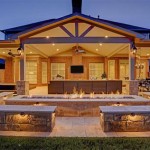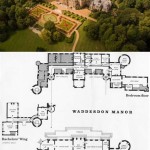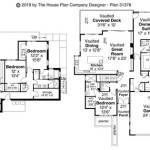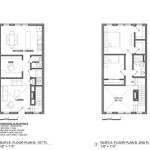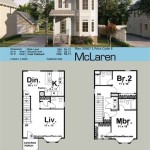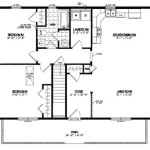Decoding the 2 Bedroom Apartment Floor Plan With Dimensions
The selection of an apartment hinges significantly on the suitability of its floor plan. Among the various configurations available, the 2-bedroom apartment floor plan is particularly popular, catering to a diverse range of individuals and families. Understanding the dimensions and layout of these plans is crucial for making an informed decision, ensuring comfort, functionality, and optimal utilization of space. This article delves into the key considerations when analyzing a 2-bedroom apartment floor plan with dimensions, exploring factors that contribute to a satisfying living experience.
A 2-bedroom apartment typically offers a balance between affordability and space, making it an attractive option for small families, couples, or individuals seeking a dedicated home office. The precise dimensions, however, can vary considerably depending on the building, location, and intended design. Factors like the placement of windows, the shape of the rooms, and the inclusion of amenities impact the overall usability of the space. Therefore, a thorough examination of the floor plan, paying close attention to the indicated dimensions, is essential.
Key Considerations: Room Sizes and Layout
The dimensions of each room within the 2-bedroom apartment are paramount to its livability. The master bedroom, ideally, should comfortably accommodate a queen or king-size bed, along with bedside tables and sufficient walking space. Dimensions around 12ft x 14ft are generally considered adequate for a master bedroom, but smaller dimensions may necessitate careful furniture selection. The second bedroom, often smaller than the master, may be better suited as a guest room, home office, or children's room. Its dimensions should be assessed in relation to its intended purpose. A size of 10ft x 12ft might be sufficient for a single bed and a desk, while a larger size might be needed if it is to serve as a children's bedroom.
The living room serves as the central gathering space and requires ample area for seating, entertainment, and potentially a dining area. Dimensions of 14ft x 18ft or larger are often preferred to provide a comfortable and spacious living environment. The kitchen's dimensions and layout are equally important. A well-designed kitchen should offer sufficient counter space, storage, and room for appliances. Galley kitchens, linear kitchens, and L-shaped kitchens are common configurations, each with its own spatial requirements. A minimum of 8ft x 10ft is generally required for a functional kitchen, though larger dimensions are often desirable.
Bathrooms in a 2-bedroom apartment can range from a single shared bathroom to two bathrooms (one ensuite in the master bedroom and a separate guest bathroom). The dimensions of the bathroom(s) should allow for comfortable movement and functionality. A full bathroom, including a toilet, sink, and shower/tub combination, typically requires a space of at least 5ft x 8ft. Ensuite bathrooms may be smaller, while larger bathrooms might offer additional features such as a separate shower stall or a double vanity.
Beyond the dimensions of individual rooms, the overall layout of the apartment is critical. Open-concept layouts, where the living room, dining area, and kitchen flow seamlessly together, can create a sense of spaciousness. However, these layouts may lack privacy and require careful zoning to define distinct areas. Closed layouts, where rooms are more segregated, offer greater privacy but can feel smaller and more confined. The optimal layout depends on individual preferences and lifestyle.
The placement of doors and windows significantly impacts the usability of a room. Doors should be positioned to minimize obstruction of traffic flow and maximize usable wall space. Windows should be strategically placed to provide natural light and ventilation. The floor plan should clearly indicate the location and size of all doors and windows, allowing for accurate assessment of their impact on the space.
Analyzing Storage and Amenity Spaces
Storage is a crucial aspect of any apartment, and the floor plan should indicate the location and dimensions of closets, pantries, and any other storage spaces. Closet space is particularly important in bedrooms, where it should be sufficient to accommodate clothing, shoes, and accessories. The floor plan should specify whether closets are standard reach-in closets or larger walk-in closets. Linen closets are also valuable, providing storage for bedding, towels, and other household items. The dimensions of these storage spaces should be carefully considered to ensure they meet the tenant's needs.
In addition to closets, the presence of a pantry in the kitchen can significantly enhance storage capacity. A pantry provides dedicated space for storing food items, kitchen supplies, and small appliances. The floor plan should indicate the size and configuration of the pantry, allowing for an assessment of its suitability. Some 2-bedroom apartments may also include additional storage spaces outside the main living area, such as storage lockers in the basement or attic. These spaces can be particularly useful for storing seasonal items or infrequently used belongings.
The presence of amenities such as a balcony or patio can significantly enhance the living experience. The floor plan should clearly indicate the location and dimensions of these outdoor spaces. A balcony or patio provides a private outdoor area for relaxation, entertaining, or gardening. The size and orientation of the space should be considered in relation to its intended use. A small balcony may be suitable for a single chair and a small table, while a larger patio may accommodate a full outdoor dining set.
Laundry facilities are another important consideration. Some 2-bedroom apartments include in-unit laundry, while others rely on shared laundry facilities in the building. If the apartment includes in-unit laundry, the floor plan should indicate the location and dimensions of the laundry area. A dedicated laundry room is ideal, but a laundry closet or alcove may also be acceptable. If the apartment relies on shared laundry facilities, the location and accessibility of these facilities should be considered. The floor plan may not explicitly indicate the location of shared laundry facilities, but this information should be readily available from the building management.
Finally, the floor plan should indicate the location of essential utilities, such as heating, ventilation, and air conditioning (HVAC) units, electrical panels, and plumbing access points. The placement of these utilities can impact the usability of the space and should be carefully considered. For example, an HVAC unit located in a bedroom closet may significantly reduce storage space. Similarly, an electrical panel located in a prominent location may be aesthetically unappealing. The floor plan should also indicate the location of smoke detectors and carbon monoxide detectors, which are essential for safety.
Understanding Dimension Conventions and Scale
Accurate interpretation of a floor plan requires a thorough understanding of dimension conventions and scale. Floor plans typically use standard units of measurement, such as feet and inches or meters and centimeters. The floor plan should clearly indicate the units of measurement used. Dimensions are typically indicated as length x width, with the length being the longer dimension and the width being the shorter dimension. However, it is important to verify the convention used on the specific floor plan being analyzed.
The scale of the floor plan is another critical factor. The scale indicates the relationship between the dimensions on the floor plan and the actual dimensions of the apartment. A common scale is 1/4 inch = 1 foot, meaning that every 1/4 inch on the floor plan represents 1 foot in the actual apartment. The floor plan should clearly indicate the scale used. Using a ruler or scale ruler, the dimensions of each room can be accurately measured and converted to actual dimensions. It is important to note that floor plans are often simplified representations of the actual apartment and may not include every detail.
When interpreting dimensions, it is important to consider the thickness of walls. The floor plan should indicate the thickness of interior and exterior walls. The dimensions typically represent the interior dimensions of the room, meaning the distance between the interior surfaces of the walls. The thickness of the walls should be subtracted from the overall dimensions of the apartment to determine the usable living space. For example, if the overall dimensions of a bedroom are 12ft x 14ft, and the walls are 6 inches thick, the usable living space may be slightly smaller.
Moreover, understanding architectural symbols is essential. Doors are typically represented by an arc indicating the swing direction. Windows are represented by parallel lines bisecting the wall. Stairs are indicated by a series of parallel lines with an arrow indicating the direction of ascent. Understanding these symbols allows for a more comprehensive understanding of the floor plan. Additional symbols may represent electrical outlets, light fixtures, plumbing fixtures, and other features. A legend or key should be provided to explain any non-standard symbols used on the floor plan.
Finally, verifying the accuracy of the floor plan is crucial. If possible, it is advisable to physically visit the apartment and verify the dimensions and layout against the floor plan. Small discrepancies may exist between the floor plan and the actual apartment. Measuring the rooms and features of the apartment with a tape measure can help to identify any discrepancies and ensure that the floor plan accurately reflects the actual space. If significant discrepancies are found, it is important to address them with the building management before making a decision.

2 Bedroom Layout Small Apartment Plans Floor Plan

Add Stairs More Storage Plus Patio And Or Garage House Plans Design 2 Bedroom Apartment Floor Plan

Free Editable Apartment Floor Plans Edrawmax

25 Best 2 Bedroom Apartment Floor Plan Ideas Small House Plans

2 Bedroom Apartment Floor Plan Palm Cove Tropic Apartments Plans

Third Ward Two Bedroom Apartments Jackson Square

2 Bedroom G Village At Fox River

2 Bedroom Apartment Floor Plans 550 Ultra Lofts

Apartment R 2 Bedroom Block Design David Chola Architect

2x2 B2 2 Bed Apartment Alpha Mill
Related Posts

